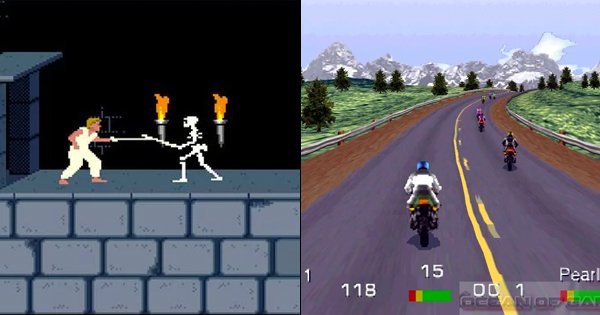When you think of gaming, what comes to mind? Xbox? PlayStation? PC games? All of these things have become staples in our lives over the past few decades. But where did it all start? In this blog post, we’re going to take a look at the history of game development, from its humble beginnings in text-based adventure and role-playing games (RPGs) to the first-person shooters (FPS) and open world games we know and love today. We’ll explore how technology has shaped game development since the 1970s and why game development is still such an important part of our culture today.
The early days of game development
The early days of game development were very different from what we see today. There were no big budget studios or AAA titles. Instead, there were small teams of passionate developers who worked on their projects in their spare time. The most popular type of game during this period was the text-based adventure game. These games relied heavily on the player’s imagination and gave them a great deal of freedom to explore the world they were in.
One of the earliest and most successful text-based adventure games was Zork, which was released in 1977. Zork was developed by a team of four people at MIT and sold over half a million copies. It was so popular that it spawned a franchise that includes several sequels and spin-offs.
Another popular genre during the early days of game development was the role-playing game (RPG). One of the earliest and most influential RPGs was Dungeons & Dragons (D&D), which was created in 1974 by Gary Gygax and Dave Arneson. D&D inspired a whole new genre of games and is still played by millions of people today.
The first commercially successful video game console was the Atari 2600, which was released in 1977. This ushered in a new era of gaming, as now people could play video games in their homes. The 2600 was followed by other consoles such as the Nintendo Entertainment System (NES) and the Sega Genesis. These consoles allowed for more complex games with graphics and sound that greatly improved over those
The rise of console gaming

The console gaming industry has been on the rise ever since the release of the first home video game console, the Magnavox Odyssey, in 1972. With the release of more sophisticated consoles like the Atari 2600 and Nintendo Entertainment System, console gaming became a mainstream pastime. Today, there are dozens of different home video game consoles available on the market, ranging from budget-friendly options to high-end systems with 4K graphics and VR support.
With the popularity of console gaming comes a rise in professional gamers. These athletes compete in tournaments for big prizes and earn a living off of their skills. The most popular games played professionally are first-person shooters (FPS) and MOBA (multiplayer online battle arena) games. Some of the most well-known professional gamers include Tyler “Ninja” Blevins, who earned over $10 million in 2018 playing Fortnite, and Sumail “Suma1L” Hassan, who won over $6 million playing Dota 2.
As professional gaming becomes more popular, we’re likely to see even more growth in the console gaming industry. New technologies like 5G and cloud streaming will make it easier than ever to play games on the go, and we can expect to see even more immersive experiences thanks to virtual reality (VR). With so much potential for growth, it’s an exciting time to be a gamer!
The advent of PC gaming
The late 1970s saw the advent of personal computer (PC) gaming. Games such as Zork and Star Trek: The War Game were developed for mainframe computers and sold commercially in conjunction with hardware vendors. However, the costs associated with these games prevented them from becoming widely popular. It was not until the early 1980s that PC gaming began to take off. This was due to two factors: the introduction of affordable home computers such as the Commodore 64, and the development of a new type of game known as the first-person shooter (FPS).
The FPS genre was pioneered by games such as Castle Wolfenstein and Doom. These games put players in the shoes of a protagonist who must navigate through enemy-filled environments while shooting at anything that moves. They proved to be immensely popular, and their popularity only increased with the release of Quake in 1996. Quake popularized 3D graphics and multiplayer gaming, and laid the foundations for many of today’s most popular genres.
Today, PC gaming is more popular than ever before. There are countless different genres to choose from, and new games are released on a daily basis. Whether you’re looking for an immersive singleplayer experience or some competitive multiplayer action, there’s sure to be a game out there for you.
The birth of online gaming
The birth of online gaming can be traced back to the early days of role-playing games. Early examples of online gaming include “MUDs” (multi-user dungeons), which were popular in the 1980s and 1990s. These early games were text-based, with players typing commands to control their characters.
One of the earliest and most influential MUDs was “Adventure”, which was created in 1975. This game spawned many imitators, and is credited with popularizing the genre. The first commercial MUD, “Britannia”, was released in 1980.
Online gaming really took off in the 1990s with the advent of graphical MUDs and the first MMORPGs (massively multiplayer online role-playing games). These games allowed hundreds or even thousands of players to interact in real-time, creating a virtual world that could be explored and conquered.
Some of the most popular early MMORPGs include “Ultima Online” (1997), “EverQuest” (1999), and “Dark Age of Camelot” (2001). These games laid the foundation for modern MMOs, which continue to grow in popularity to this day.
The mobile gaming revolution
The mobile gaming revolution has been driven by the proliferation of mobile devices and the ever-increasing demand for gaming content. Mobile games are typically designed for quick, easy gameplay and are often free-to-play or ad-supported. In recent years, mobile gaming has become increasingly popular, with estimates suggesting that there are now more than 2 billion active mobile gamers worldwide.
The rise of mobile gaming has been accompanied by a number of significant trends, including the increasing popularity of ‘freemium’ games, the growth of esports, and the rise of independent game developers. These trends have had a major impact on the games industry as a whole, and on the way we play video games.
The future of game development
The future of game development is looking very bright. With the advent of new technologies, game developers are now able to create experiences that are more immersive and realistic than ever before. We are also seeing a shift towards more independent and smaller scale projects, as the barriers to entry for game development have lowered significantly in recent years.
This is an incredibly exciting time to be involved in game development, and we can’t wait to see what the next few years have in store for us.

